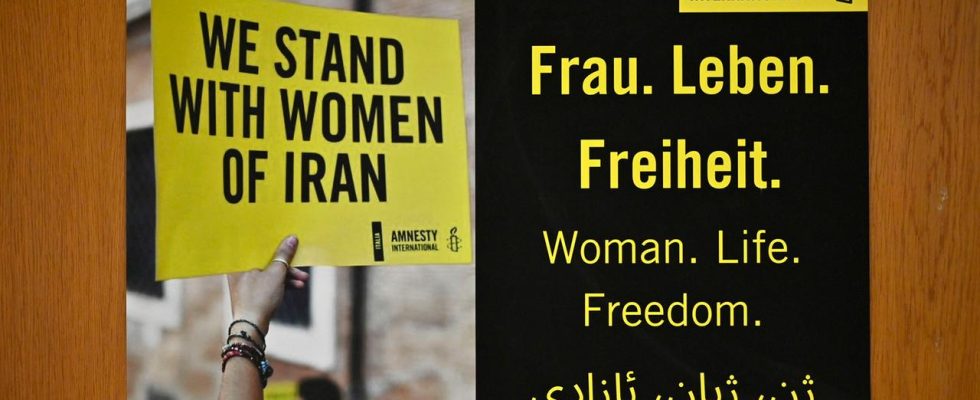Iranian security forces raped and tortured women, men and minors in detention in connection with the nationwide protests in 2022. This emerges from a recent report by Amnesty International.
She took part in a demonstration in Tehran against the regime of the Islamic Republic and publicly took off her headscarf – like thousands of women in Iran during the 2022 protests. She was then arrested by the Revolutionary Guards and raped several times during her two months in pre-trial detention. In a recent report, Amnesty International describes what must have happened to a woman named “Maryam” and many others during the women’s protests after the death of Jina Mahsa Amini.
“There is no God here”
From the moment of her arrest, Maryam describes in a memoir that she was insulted with obscenities. During her interrogation, the revolutionary guards raped her and threatened to bring her sister here and rape her in front of her. When she begged the Islamic Republic police officers to let go of her, citing God, one of them replied: “There is no God here. We are your God. We will bury you and no one will find out.”
The report documents 45 such cases. 26 men, twelve women and seven minors describe rape, gang rape and other forms of sexual violence by members of the secret service or security forces. According to consistent reports, none of them received medical care. Maryam reports that a woman who was imprisoned with her tried to take her own life after she was released.
“One of the most brutal weapons”
Since employees of the human rights organization Amnesty International are no longer officially allowed to enter Iran, they spread a call in the country to describe prison conditions after an arrest. “84 affected people, doctors, therapists and lawyers have reported,” explains Amnesty International press spokeswoman Ellen Wesemüller. The number of unreported cases is probably many times higher: more than 20,000 people were arrested during the wave of protests in Iran last year.
Julia Duchrow, Secretary General of Amnesty International in Germany, said: “Sexualized violence is one of the most brutal weapons in the arsenal of the Iranian authorities to humiliate protesters and suppress criticism in order to remain in power at all costs.”
Perpetrators from many areas of the state
According to Amnesty’s findings, the perpetrators are members of the Revolutionary Guard, the paramilitary Basij militia, the Ministry of Intelligence and various departments of the security forces, including the public security police, the investigation unit and other special units.
Survivors include women and girls who removed their headscarves and men and boys who took to the streets to protest against the regime. The youngest victim is 14 years old.
No perpetrator has been charged yet
Documenting sexual abuse in Iran is difficult for several reasons, says Wesemüller: Those who have been so brutally humiliated and raped by state actors are burdened with shame, but also fear for themselves and their own environment, because the regime often also affects their families threaten victims. Injured women in particular often do not dare to go to the hospital after being raped – for fear of being arrested again. If possible, they sought medical help from acquaintances or friends.
The deep physical and psychological scars for survivors often last a lifetime. And then there is the certainty that the crimes will neither be charged nor prosecuted. Duchrow explains that the perpetrators within the secret services and security forces do not have to justify torture: “Not a single one of them has been charged so far.”
Acts of violence often occur immediately after arrest
According to the memory protocols, the rapes mainly took place immediately after the arrest and in improvised detention facilities and police cars – in places where the perpetrators could also escape the eyes of the judiciary and the public.
Also the ARD There are reports of massive violence and threats from security forces. Many people are said to have been arrested and then held for several hours or days in buses or schools and residential buildings that had been converted into detention facilities. Rape and abuse are said to have occurred there.
Wesemüller from Amnesty International says that the report does not show isolated cases, but rather a systematic pattern. Rape and sexual violence by security forces have a long history in the country: such attacks occurred during demonstrations between 1983 and 1988. Even after the major protests in 2009, there were repeated reports of arrested protesters who had been raped and tortured by security forces.
Left alone with the lifelong consequences
For conflict researcher Robert Nagel at the Institute for Women, Peace and Security at Georgetown University in Washington, rape appears to be an integral part of the Iranian security authorities’ repertoire of violence. This suggests that it is part of the repression strategy. The reports painted a picture of violence tolerated – implicitly or even explicitly – with the aim of suppression and repression.
Although he has not yet seen any reports or evidence that officers have ordered rape, the largely consistent accounts from Amnesty International and Human Rights Watch suggest in his eyes that rape and sexualized torture are committed by soldiers, police officers, agents or members of the military Revolutionary Guard are not banned. The acts would not be actively prevented and would therefore be implicitly tolerated by the regime.
“Maryam,” the report says, is still suffering from the consequences of mass rape today. At first she only told her mother about the sexual abuse because she was still a virgin at the time of the rape and was afraid her fiancé would leave her if he found out about it. “Maryam” has now had several operations to restore her hymen. At least, says the woman, her honor is not completely lost.

